If you want to learn How to Grow Papaya tree and all about how to take care of it, here is all the information you need!
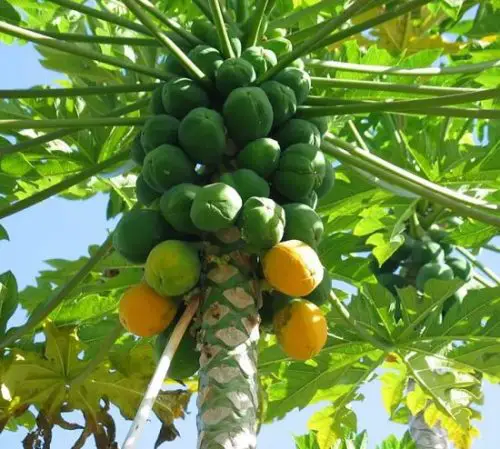
Papaya tree (Carica papaya L.) is native to the tropics of Mexico and Central America and is now grown almost all across the world in subtropical, tropical, and arid climates. In the United States, they are grown in Texas, California, Hawaii, Arizona, and Florida. Major Papaya-producing countries are India, Dominican Republic, Brazil, and Mexico.
This fruit is known for its high nutritional value, great taste, and medicinal properties. After all these facts, let’s have a look at How to Grow Papaya below.
USDA Zones: 9-11
Difficulty: Easy
Other Names: Banane de Prairie, Caricae Papayae Folium, Carica papaya, Carica peltata, Carica posoposa, Chirbhita, Erandachirbhita, Erand Karkati, Green Papaya, Mamaerie, Melonenbaumblaetter, Melon Tree, Papaw, Pawpaw, Papaya Fruit, Papayas, Papaye, Papaye Verte, Papayer, Papita.
Papaya Tree Information
Papaya is a herbaceous plant of relatively rapid growth and short life. This is the reason why it’s not commercially profitable to cultivate mature papaya trees for longer than 3 years because the fruit yield gets low afterward.
The tree has a hollow, segmented, and erect single stem and no branches. It presents many large, lobed leaves, which look highly ornamental. The plant height can reach up to several meters (usually 6-20 feet), and it has a shallow root system, making it an excellent choice for container growing.
The fruit comes in various forms: shapes and sizes, depending on the cultivar and type of flower. If you want to learn about the best-tasting papaya varieties, read this article!
Papaya Tree Pollination & Propagation 
If you’re growing papaya, you must know that papaya comes in three sexes: male, female, and hermaphrodite (self-pollinating). Male papaya trees must be eliminated as they don’t produce fruits. Female papaya trees require male trees for pollination. In orchards and papaya plantations, generally, 1 male tree per 10 female trees is grown.
Hermaphrodite (self-pollinating) papaya trees are self-pollinating and don’t require male trees for pollination. Many commercial growers plant them! If you’re planting papayas, you will need to have either female or self-pollinating papaya trees to harvest fruits.
Our recommendation for you is to buy seeds from a quality source instead of scooping them out from a papaya fruit you bought from the market. This way, you’ll know what you’re buying and get a self-fertile, bisexual tree. Most of the hybrid varieties are either bisexual or female–it is better to buy them.
If you don’t want to germinate seeds, the best option is to buy young papaya plants from a nearby nursery, or you can find them online. Many sellers ship them! If you’re sowing seeds obtained from the fruits, choose seeds from elongated fruits instead of rounded ones. Elongated fruits have a 66% probability of hermaphrodite (bisexual) seeds and 33% female seeds.
Tip: Cross-pollination from hand is required for the pollination of female papaya trees.
How to Grow Papaya in Pots?

Growing papaya in pots is not difficult, considering it is a short-living small tree with shallow roots. You can grow any papaya variety in a pot and cut the top off to shorten it. However, it is better to choose a dwarf variety if you’ve options available. Hawaiin papaya trees are considerably shorter than Mexican ones and seldom grow over 8-10 feet!
Wondering how to grow papaya from seeds? To grow papaya from seeds, start by selecting ripe and fresh seeds from the papaya fruit. Then, plant the seeds in a well-draining potting mix, keep them moist, warm, and in a sunny location until they germinate and grow into seedlings.
Choosing a Container
A pot that is at least around 16-20 inches in diameter and 12-16 inches deep should be sufficient. If you can get bigger size pots, that is even better–Old drums, barrels, and buckets are also good choices.
Sow the seeds directly in the final pot you intend to use for growing papaya trees later because this fruit doesn’t transplant well sometimes.
Growing Papaya from Seeds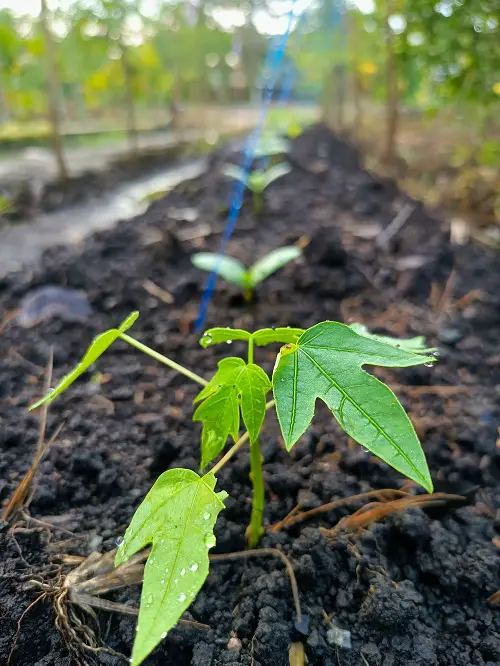
Seeds must be given treatment before sowing for germination:
- The first method is to simply wash the seeds to remove the gelatinous coating before sowing and go to step five below.
- Another method is to immerse them in a container full of neutral water for a period of 4 days. Change the water twice a day. After 2 days of soaking, separate the seeds floating on the surface from those that have settled down.
- Leave the seeds that are settled down for another day. After this time, the seeds that float up again must be removed. This way, only viable papaya seeds will be left. On the last day, when changing the water, add fungicides to it.
- After this process, keep the seeds on a cotton cloth for 2 days, keeping the seeds moist. Once the white dot in them can be observed, they are ready for sowing.
- Proceed to sow the seeds directly on the ground or in the container. If you’re using seed pots, make sure they’re biodegradable, as papaya plants don’t transplant well, and you’ll have a low success rate otherwise.
- Seeds will germinate in 1-3 weeks. It can take up to 5 weeks in less ideal conditions, so don’t give hope early! The optimum germination temperature is around 70 F (20 C).
Planting Papaya Tree
Once the seedlings germinate, sow them directly at the desired spot. If you’ve got plants from a nursery, prepare the ground well before planting. Dig a hole that is of the same depth as the rootball of the plant but twice wide.
Apply slow-release 16-48-0, 18-46-0, or balanced 15-15-15 fertilizer according to the product’s instructions but in a weaker dose at the base of the hole. Later, fill it with a thin layer of soil to prevent the plant roots from directly contacting the fertilizer.
The base of each plant should be 1 cm above ground level to prevent rot at the stem base. After transplanting, a fungicide can be applied to ensure greater protection, especially if planted during rainy days.
Learn How to Grow a Strawberry Tree
How to Grow a Papaya Tree in a Cold Climate?
Papaya is a tropical fruit tree, but if you are thinking of planting it in a temperate climate, plant it in a large pot and try to overwinter it in a well-protected area, like a greenhouse.
There’s another way to grow papaya plants. You can start the seeds inside your house during fall or early spring. When the weather outside gets warm enough, you can plant the seedlings in your yard. The trees will continue to grow until the cold weather arrives, which might kill them. However, if you’re lucky, you may still get some tasty papayas. Even if you don’t get any fruit, the plants will still look pretty.
- If you don’t have a greenhouse, keep it indoors during winter in a warm room.
- Cover the pot with bubble wrap to insulate the roots and provide protection.
- Reduce watering and stop fertilizing in winter.
Requirements for Growing Papaya Tree
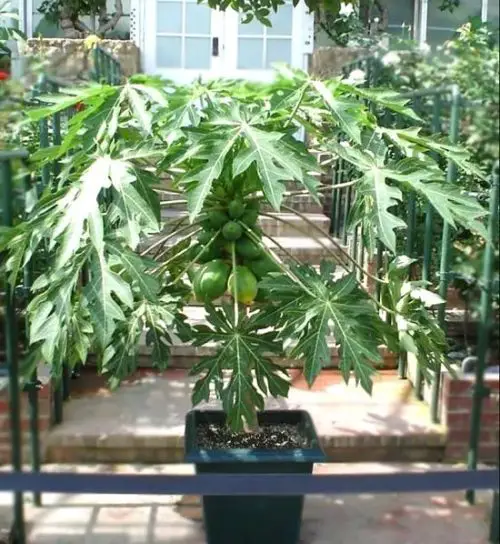
Location
The papaya needs plenty of sun due to its high photosynthetic activity. It is impossible to grow it in the lack of sunlight, so make sure it gets 6-7 hours of it every day.
You need to keep in mind when choosing a location for growing papaya trees–they are not the strongest and must not be planted in a too windy spot.
Soil
Good soil preparation practices are key to growing papaya, such as deep plowing and mixing a lot of organic matter. Therefore, the main characteristics of soil for growing a papaya tree are the following:
- Loose and Moist
- Good Drainage
- High Organic Matter Content
- pH Level 5.5 to 7 (Neutral)
- Fertile and Deep
The ideal growing medium must be loamy and have an adequate amount of organic matter, good moisture retention capacity, and efficient drainage. Soil depth is also an important factor for root development.
Soil that is more than a meter deep is suitable. Compact soil must be avoided; also, clean the rocks or other debris that could limit the development of roots till the following depth before planting.
Drainage is crucial in papaya cultivation. The proportion of sand, silt, and clay determines the texture and soil structure:
- Sandy soils have better drainage than clay. However, sandy soils that are low in organic matter have reduced water retention capacity, which must be avoided.
- In clay-rich soils, water movement remains slow, leading to root rot, slow development of the plant, and inhibiting nutrition uptake.
- In very alkaline soils (above pH level 8.0), Zinc, iron, and other micro-element deficiencies can occur.
Watering
Water is the main contributor to the plant (this plant is composed of about 85% water). During germination and the first few months after planting, papaya needs a lot of water at that stage.
In the dry season, to get the optimum results in production, watering must be increased again. Keep the soil slightly moist but not wet. As a rule of thumb, water the papaya plant deeply when the top one inch of soil dries out.
Excess water causes the yellowing of young leaves, premature fall of flowers, and root rot. Low moisture in the soil can lead to slow growth, accelerated aging, premature foliage, and fruit drop.
Temperature Tolerance
It is also an important factor that determines if the plant will grow or not. Papaya is one of the easiest fruit trees you can ever grow. The optimum temperature for growing papaya ranges between 68-90 F (20-32 C). Low temperatures lead to slow growth of the plant, and higher temperatures cause low production.
The papaya tree can bear cold temperatures down to 32 F (0 C) for a short period of time. In hot climates, it can tolerate temperatures above 100 F (38 C). However, due to extreme temperatures above a hundred Fahrenheit, heatwaves, and drought, flower buds fall, and the plant suspends its growth.
Papaya Plant Care
Papaya tree care is easy if you grow it in warm conditions, in full sun:
Mulching
Mulching a papaya tree with organic matter helps in retaining moisture, which is essential in hot climates. It also saves it from hot and cold weather.
Fertilizer
Papayas are heavy feeders, so you will have to take care of them when it comes to fertilization. Apply plenty of aged manure or compost regularly near the base of your plant. Use a balanced fertilizer once in 2-4 weeks when the tree is actively growing.
When the tree starts to bear fruits, reduce the frequency to once in 7-8 weeks and dilute the feed to 1/2 of its recommended strength.
Pests and Diseases
Pests that can attack it are fruit flies, mites, black vine weevil, aphids, leafhoppers, and whiteflies. It also suffers from soil fungi, powdery mildew, fruit rot, papaya ringspot virus, and nematodes.
Harvesting Papayas
Papaya fruit set occurs 9-12 months after planting. The fruit is sensitive to sunburn, and it must be separated from the tree carefully using plastic gloves or something similar. Pick it lightly with a twist or use a short knife, leaving a 0.5 cm stalk.
Harvesting should be done according to the following maturity indices:
1. 0% Ripe: Completely green but well developed.
2. 10-15% Ripe: Color change, one or two yellow stripes with 10-15% yellow surface shell surrounded by a bright green color.
3. 25% Ripe: 25% of the surface of the shell is yellow, surrounded by a clear green color.
4. 75% Ripe: 75% of the surface is yellow.
5. 76-100% Ripe: The surface of the shell has a yellow to orange color.
Fruits must be collected in the early hours of the day and must not be exposed to the sun.
Some Interesting Facts!
Papaya (Carica papaya), a native to Central America and is now widely grown in tropical and subtropical areas globally. It is a large, short-lived perennial plant.
- A single trunk of the papaya tree can grow up to 30-35 feet when it reaches its full maturity.
- The palmate leaves can reach out to 3-4 feet in width and are heavily lobed.
- Usually, the fruit flesh is yellow, but some also have ones with red and orange-colored fruit flesh.
- It’s probably the breakfast fruit and contains enzymes that improve digestion.


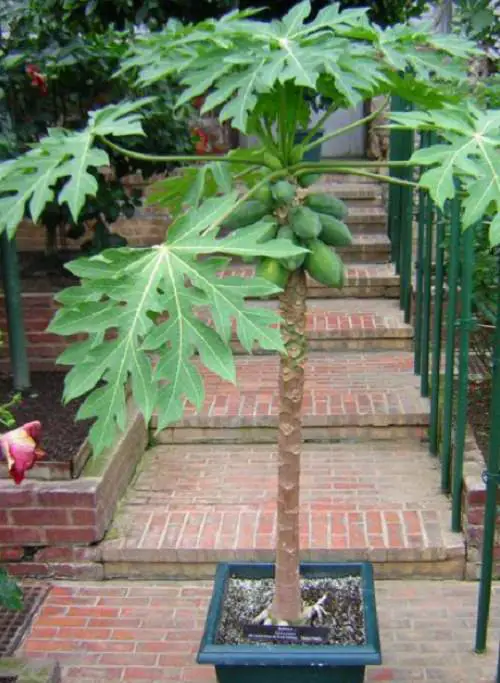
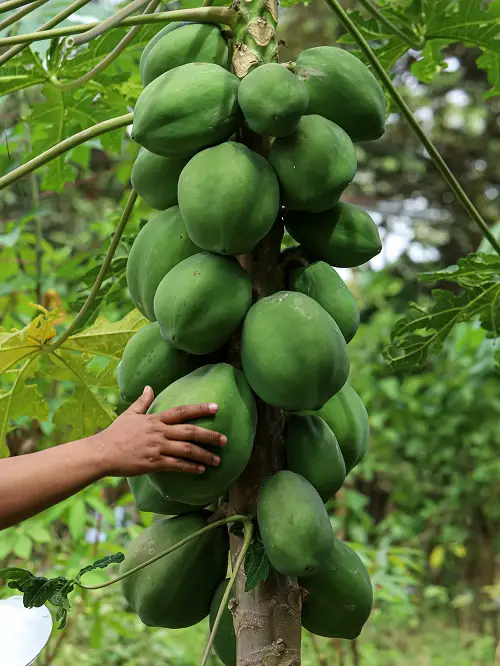

Usually I never comment on blogs but your article is so convincing that I never stop myself to say something about it. You’re doing a great job Man,Keep it up.
You have given all details to grow papaya. Very useful
Thank you
Question then – I have a green papaya tree growing for about 3 years, started as small tree. There are now two main stalks, one with small fruit and another with beautiful which flowers. Last year the small fruit stayed small. This year it looks about the same – not seeming to be growing. {I can send a photo} Is this enough to make a suggestion?
Very informative thanks! What about hydrophonic growing of papaya?
I have transplanted at least 8 papaya.Not one of the transplants died. I have never fertilized them and they are growing on the outskirts of oak trees were the soil is highly acidic. In my area on the gulfcoast of Florida they grow like weeds.
hello , would you please tell me at which height did you transplant them?
I HAVE 2 PAPAYA ONE YEAR OLD PLANTS IN MY BACKYARD IN SYDNEY, AUSTRALIA. LEAVES RAE DEVELOPING BLACK SPOTS AND GRADUALLY DYING. I AM AFRIAD THE PLANTS THEMSELF MAY DIE SOON IF NOT TREATED IMMEDIATELY. APPRECIATE IF ANY ONE KNOWS THE TREATMENT AND PL LET EM KNOW. I WOULD HAVE ATTACHED PHOTO IF THERE IS ANY PROVISION HERE.
neem oil will help make sure you are not watering too much and that it gets plenty of air and direct sun.
I just started growing papaya from seed, and this was before seeing your article. I only washed the seeds and planted them. Only four seeds germinated, and one had the seed shell covering the top, so it died in a few days. The three remaining seedlings were transplanted to Styrofoam cups when one-inch high. So far they are doing well. I plan to transplant again when they out-grow the cups. The planting medium is 3 parts potting soil, 1 part clay soil and a couple tablespoons of plant food.
Confused about harvesting papayas from our backyard. Article defines “Maturity Indices” but doesn’t recommend at which ripeness index is best to pick. Does one harvest on tree when ripe (yellow) for maximum sweetness, or some other level?
Also, there are many fruit of similar age (lowest on trunk are oldest) but there are a few large fruit surrounded by smaller ones of same age. Do you recommend thinning out the smaller fruit to give room and preserve tree’s energy to nourish the large fruit and allow them to grow larger, or leave all on the tree?
Unfortunately I grew my tree in a corner of my front yard. It grew very tall.
Is there a way to stunt my tree? I would not want it to fall on my neighbors roof.
just cut it down to about a meter off the ground. New branches will grow off the side.
Great article. Been growing papayas in Hawai’i and i can’t stress enough how important good drainage is to avoid root rot (as you have mentioned). Also, i sometimes pile small stones above the planting surface approx 6 in high and cover with soil after planting. This helps with the drainage and root stability during gusts.
My neighbor just gave me 4 rooted papaya stems approx 15-25” tall. Can I plant them all together?
I “accidentally” started a garden of papaya plants from the papaya seeds I dumped there with my compost! I live in North Carolina, so I think I’ll pot some of them and bring them inside when it gets cold over the winter. Hoping I can still provide enough sunshine for them to survive indoors, until I can bring them back outside again. I love papaya, and I’ll be thrilled if they ever bear fruit!
I am from Punjab Pakistan.i wanna grow papaya.so plz tel me about this plant can suitable in our area.
Hello Aziz, you can, but it will probably be difficult. I believe your area can become as hot as 54c. As the article says, when the temperature is above 37c, you will have to take it indoors and keep it in a room around 37c or lower to keep to keep the plant from suspending its growth and dropping its flower buds too early to develop fruit. The optimum tempature is 20-32c, but can tolerate 2-37c. I hope this helps and I wish you success
I have read on some blogs that after fruiting the tree should be cut back at about 3-4 foot above the ground. Is this recommended? Can the tree withstand cutting back repeatedly season after season? I am now picking the fruit off of my papaya tree (in south Florida) as the fruit have been ripening. But the tree is not growing out new leaves and is dropping the old ones. Fertilizer spikes in the surrounding ground seems to have helped this year.
This was amazing source of information, I’ve planted 20 seeds, 14 came out of grounds, I’ve put them inside closed to window at a temperature of 20-35 C. They are now 2 inches tall I transferred them to small glasses. I’ll move them to soil in a month time when they are 10 inches in height. This articles was great help.
I live in Daytona Beach ,Florida . We have a Papaya Tree growing along side of our apt. buld. on the West side. This was NOT planted , but came up on it’s own ! IE: some one dropped a seed (?) There was no care to this tree at all. Yet in gust a short time it has produced a lot of fruit ! It is abought 15 feet tall and had 40 to 50 fruit on it. People here have picked as much as they can reach, all green for now. This was a supprise for me . Yes I have four of the fruit . Picked to day !7, July 2020 . This is really cool. Hope we get more next year. Thank you .
Offering instructions the hills are into the west only works when you are able to see them.
After some time, to be precise, 3 years of papaya growing. The first papaya grew up from my compost, that was three years ago. It grew to about 1.4 meters, and decided it was going to blossom. One fruit set on the plant, but did not develop and eventually fell off. This was somewhat disappointing, so off to Bunnings, and I found 2, 1.0 meter papaya plants, which came home with me. I planted them by the one which grew up in my compost. They were all developing well. Till the back wash hose on my swimming pool burst, and flooded 2 papaya with salt water, before I realized that the swimming pool water was emptying out on the garden bed. Unfortunately, salt water and saturated soil, are a recipe for disaster for papaya. My home grown papaya plant and ine of the bunnings variety turned up their toes with root rot and salt burn. But the other bunnings papaya is being very fruitful and flowers are in abundance. Now the long wait for the delicious fruit to develop. I planted pineapple 4 years ago, from pineapple tops, after 8 months from flower to fruit. They are a long haul fruit as well. Regards Ross.
My Papaya planted in pot grown well flowering but not fruiting
You will have to hand pollinate the flowers, assuming that you have a hermaphrodite papaya.
Can you help me please? It’s my first time planting papaya. I have 30 stems in a bunch growing in one spot. I didn’t know how to do this… but anyway how do I transfer to another spot to make 1 or 2 successful trees? And when? They are about 4 or 5 inches from soil and sooo healthy looking. Do I just leave all the bunch alone? What would happen if I did?
Forgot to say my papaya is in backyard growing in clay soil.
This is an excellent article on papaya planting. I have never grow papaya plant. Know I like to grow papaya plant.
muito bom
I have a bunch of them that sprouted from my compost. Unfortunately I live in Zone 5 on a very shady lot, but I’m going to try to overwinter them in my sunniest room. Thanks for the tips. Great post!